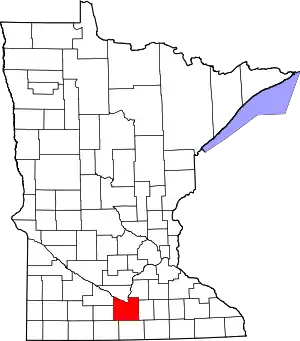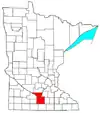Lake Crystal, Minnesota
Lake Crystal is a city in Blue Earth County, Minnesota, United States, established in 1869.[5] The population was 2,549 at the 2010 census.[6] It is part of the Mankato–North Mankato Metropolitan Statistical Area.
Lake Crystal | |
|---|---|
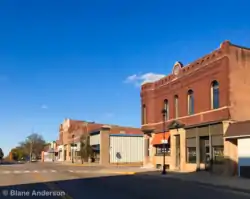 Main Street in 2019 | |
| Motto(s): "The Place To Be" | |
 Location of Lake Crystal, Minnesota | |
| Coordinates: 44°06′21″N 94°13′08″W | |
| Country | United States |
| State | Minnesota |
| County | Blue Earth |
| Government | |
| • Type | Mayor - Council |
| • Mayor | Brad Ahrenstorff |
| Area | |
| • Total | 1.71 sq mi (4.42 km2) |
| • Land | 1.71 sq mi (4.42 km2) |
| • Water | 0.00 sq mi (0.01 km2) |
| Elevation | 994 ft (303 m) |
| Population | |
| • Total | 2,549 |
| • Estimate (2019)[3] | 2,487 |
| • Density | 1,457.80/sq mi (562.83/km2) |
| Time zone | UTC-6 (Central (CST)) |
| • Summer (DST) | UTC-5 (CDT) |
| ZIP code | 56055 |
| Area code(s) | 507 |
| FIPS code | 27-34190 |
| GNIS feature ID | 0646340[4] |
| Website | ci.lake-crystal.mn.us |
History



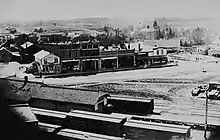

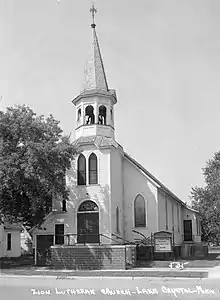
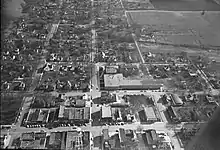
First arrivals
In 1853, two families from small towns near Ithaca, New York, left their homes and traveled west. One was 32-year-old William Riley Robinson. In June 1854 Robinson and his companion Lucius O. Hunt traveled from Wisconsin to Blue Earth County. Robinson and Hunt arrived and came upon the three nearby lakes, Loon, Crystal, and Lily, and marveled at their beauty. They returned for their families and headed back to settle in the Lake Crystal area. The families were joined by two other men and their families, Calvin Webb and Samuel Thorne. Robinson and his family settled in a log cabin on the south shore of Crystal Lake, a few feet south of where the Robinson House is today. Hunt and his family settled in a log cabin on the south shore of Lily Lake, where Holy Family Catholic Church is now. Each man took plots of land one mile long and half a mile wide (the dividing line being modern-day Main Street), the deeds to which were signed by President James Buchanan. Webb settled in the Judson Township, while Thorne took a claim on Crystal Lake. The local natives were great beggars who kept tabs on the newcomers. The Sioux even continued to hold their tribal dances in the Grove on Crystal Lake, now Robinson Park. One day, Mrs. Robinson was trying to put her baby to sleep while a native chief, Standing Buffalo (Tatanka-Najin) and his friends were making loud yelps. After the natives made a frightening yelp, she grabbed a whip and almost struck Standing Buffalo. The whip missed, and Standing Buffalo gave her a nasty look and calmly walked away. If Mrs. Robinson had hit him, the settlement would most likely have been massacred. In August 1862, William Robinson was awakened early one morning by a knock at his door. It was an old Native American friend of his and several other natives in war paint. They told him and his family to leave the settlement, as the people there and of the surrounding territory were to be massacred. The natives also warned to not tell anyone, especially Hunt, as Robinson's Native friend wanted to scalp him personally. Days passed, and Robinson noticed an absence of natives in the area. He sneaked into a nearby camp and learned that everything his native friend had said was true. Robinson began to warn the settlement, who all escaped to the fort at Mankato. The natives discovered the settlement empty, and, in a rage, burned it. Eventually the Native uprising was subdued and the settlers returned and rebuilt their homes. Hunt built a brick house in 1869 that was torn down in the mid-1900s, where Holy Family Catholic Church is today. Robinson built his brick house in 1870, which still stands as a historical building on Robinson Street.[9]
Town founding and 1800s
Originally, in June 1857, a town named Crystal Lake City was planned out on the southwest shore of Crystal Lake, but it failed to become reality. In October 1868, The Valley Railroad, later the Chicago, St. Paul, Minneapolis, & Omaha Railroad, was competed in the area. The railroad, after looking for potential locations, choose Lake Crystal for a new station. And so Lake Crystal began along the railroad, and was platted by Robinson and Hunt in 1869.[10] The railroads' engineer, General Judson W. Bishop of Saint Paul, named the town after nearby Crystal Lake.[11] A post office began operation in Lake Crystal in 1869, and has been in operation since.[12] By December 1, 1869, the town possessed a grain elevator, hotel, school house, grocery and drug store, hardware store, two general stores, harness shop, cooper shop, and a doctor's office.[9] Lake Crystal was incorporated as a city on February 24, 1870.[10] Its first newspaper, The People’s Journal, started in March 1870.[13] The period between 1870 and 1895 is generally known as the “Wheat Era”; most local farmers put nearly all their crop land into wheat. Lake Crystal's economy was adversely affected by the grasshopper invasion of 1873, when millions of grasshoppers devoured all the crops. The plague lasted until June 1877, when the grasshoppers fled. It took years to recover; only in 1882 were good quantities of wheat again marketed at the local grain elevator. In 1879, the Elmore railroad line was completed, with Lake Crystal as a junction between this new line and the old main line. This rail line connected Lake Crystal to Garden City, Vernon Center, Amboy, Winnebago, Blue Earth, and Elmore. No fewer than 23 trains passed through the town each day. In 1882, land was purchased from the railway for $100 and a new, two-story brick schoolhouse was built.[14] This school building was added onto in 1895 and 1905 and demolished in 1972.[9] In 1885 a 16-man volunteer fire department was founded to combat the several outbreaks of fire in the area. On September 20, 1887, a fire broke out at 3AM in the town's business block. A man was seen pouring gasoline throughout one of the buildings, then lighting it. Within a few hours the fire was under control; it was extinguished with the help of Mankato's Fire Department. This fire damaged and destroyed around seven buildings.[15] Also in 1887 All Angels Episcopal Church was built on the corner of Main and Howard Streets; it was torn down in 1964. In 1890 Methodists built a church on the corner of Humphrey and Crystal Streets, the United Methodist Church. In 1893 the Lake Crystal Boat Club built a boat pavilion at modern-day Robinson Park. The Boat Club also launched a steamship, the “New Era”, which is believed to have sunk near the lake's south shore.[16] Norwegian Lutherans built a church on the corner of Anna and Shepherd Streets in 1893, later renamed Zion Lutheran.[17] In 1894, the Graif Brothers Flour Mill was built, which marketed flour to locations such as Iowa, Wisconsin, Illinois, and Glasgow, Scotland. By 1895 Lake Crystal had over 1,100 residents.[9] Catholics built their first church on the west end of Humphrey Street in 1896.[18] In November 1898, space was made for a new electric light plant between the Graif Flour Mill main building and engine room. Power-line poles also arrived and were installed along 16 streets. Lake Crystal received electricity in December 1898. The Welsh Calvinistic Methodist Church was constructed in 1899 on the corner of Prince and Crystal Streets.
1900s

The Graif Brothers Flour Mill burned down in 1901 which would be replaced by the Lake Crystal Milling Company Plant[19] in 1902, and would be torn down in the late 1980s. The Lake Crystal First National Bank building was built in 1902 on Main Street, and would hold the bank until the 1920s. In 1905 the main railroad and depot in town was moved north of town to the south shore of Lily Lake, where the railroad resides today. In 1908, the first water tower was built, standing at around 110 feet tall, and would be torn down in 1995. On October 10, 1919, the Lake Crystal American Legion John W. Roth Post 294 was established by fifteen Lake Crystal World War One veterans.[20] Also in 1919, Main Street would be paved, along with the reconditioning of the sewer system. The Lake Crystal Tribune began publishing weekly in December 1921 and is still in publication.[21] In 1926 a new hospital was built, run by Dr. Fred Franchere on Main Street, which also operated an ambulance. Also in 1926 a new school addition was added, which would be demolished in 2007. In 1937, the City Municipal Power Plant was built, and is still provides power to the city today.[9] On January 1, 1937 an accidental fire destroyed the Welsh Calvinistic Methodist Church. The present-day First Presbyterian Church was built in 1937 on the corner of Prince and Crystal Streets. The Minnesota Valley Gas Company began to service the community in 1941. Trinity Lutheran Church was built in 1947 on the corner of Watonwan and Main Street. The present-day Holy Family Catholic Church was built in 1951, replacing the Humphrey Street Catholic church.[18] In 1954, another school addition was built, which would be demolished in 2007. Zion Lutheran Church would move from its old site, and build a new church to its present site on the corner of Robinson and Crystal Street in 1957.[17] In 1959, the Crystal CO OP elevator was built. It would have 5, 50,000 bushel and 2, 200,000 bushel grain bins added on to it in the late 1960s to early 1970s.[22] Highway 60 would be moved closer to the railroad and would become a four-lane highway in 1968, replacing the old highway also known as Lily Street. A new post office was built on the corner of Prince and Main Street in 1970, which is still in use today. In 1971, an elementary school was built along County Road 9. The Lake Crystal National Bank was moved from 101 South Main Street to their new building in 1973,[23] which is now owned by MinnStar Bank. The city population reached around 2,068 in 1978. In the 1970s, three historic buildings were demolished on south Main Street and were replaced by the Lake Crystal Towers, a five-story apartment building built in 1978. A brand new City Hall was built in 1980 in Marston Park, and was added on to in 2017.[24] In 1983, Crystal Valley built a new, two bin, concrete grain elevator. This elevator would have 3 more larger bins added in 1985, and is still in use today.[25] Also in 1983, the Baptist's moved from their old Humphrey Street church, to their present one on Oakland Street. A new Wastewater Treatment Plant opened along County Road 20 North in 1987. The Elmore Line was removed in the 1980s along with the many grain elevators along its path. A new Lake Crystal Fire Hall was built in 1988 on Hunt Street, replacing the Fire Hall at 101 North Main Street, which is now the Police Department. In 1995 a new water tower was built between Hunt and Lincoln Streets which was painted tan, and is still in use today. In the late 1990s to early 2000s, five historical buildings on Humphrey Street were demolished. In 1999 Crystal Gardens housing developments were constructed on the end of Blue Earth Street, which now houses 40 residences.
2000s
A public Recreation Center was built on the corner of south Main Street and 510th Avenue in 2000. Which contains a public pool, gymnasium, walking track, and exercise room. In the early 2000s the Lily Lake Estates, Crystal Creek, and Nathan Street housing developments began, or were under construction. POET Biorefining built a new ethanol plant around two miles west of town along Highway 60 in 2004. In 2005, multiple houses were demolished near the intersection Main Street and Highway 60 and was replaced by the new Kevin's Market Grocery Store. In 2007 a new secondary school was built along 510th Avenue to replace the old school on Murphy Street. Crystal Seasons Senior Living Center was built on the lot that belonged to the old Lake Crystal Highschool in 2008,[26] replacing the old retirement home off Highway 60 on LaClaire Street, which was demolished. United Methodist Church sold their old building, and built a new one on the corner of Main Street and 510th Avenue, renaming it Cornerstone UMC in 2015.[27] In recent years the Crystal Waters Project has cleaned up the nearby lakes that have been contaminated over several years due to nearby farming and sludging.[28] On August 8, 2016, a storm severely damaged the 57-year-old Crystal CO OP Elevator, and would be demolished within the following months. The water tower was repainted from its original tan color to light blue in 2018.
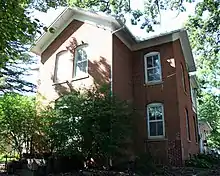
Geography
According to the United States Census Bureau, the city has a total area of 1.72 square miles (4.45 km2), all of it land.[29] The city has four lakes close by: Crystal Lake, Lily Lake, Mills Lake, and Loon Lake.
Crystal Lake is the largest of the three lakes and sits in the center of town, providing access to a fishing pier, public landings, and warm and cold water sports. Loon Lake also contains public and private landings and access to cold and warm water fishing. Lily Lake is the smallest lake, and is good for canoeing and kayaking.
Minnesota State Highway 60 serves as a main route in the city.
Demographics
| Historical population | |||
|---|---|---|---|
| Census | Pop. | %± | |
| 1870 | 360 | — | |
| 1880 | 483 | 34.2% | |
| 1890 | 824 | 70.6% | |
| 1900 | 1,215 | 47.5% | |
| 1910 | 1,055 | −13.2% | |
| 1920 | 1,204 | 14.1% | |
| 1930 | 1,173 | −2.6% | |
| 1940 | 1,319 | 12.4% | |
| 1950 | 1,430 | 8.4% | |
| 1960 | 1,652 | 15.5% | |
| 1970 | 1,807 | 9.4% | |
| 1980 | 2,078 | 15.0% | |
| 1990 | 2,084 | 0.3% | |
| 2000 | 2,420 | 16.1% | |
| 2010 | 2,549 | 5.3% | |
| 2019 (est.) | 2,487 | [3] | −2.4% |
| U.S. Decennial Census[30] 2018 Estimate[31] | |||
2010 census
As of the census[2] of 2010, there were 2,549 people, 1,063 households, and 661 families living in the city. The population density was 1,482.0 inhabitants per square mile (572.2/km2). There were 1,143 housing units at an average density of 664.5 per square mile (256.6/km2). The racial makeup of the city was 97.3% White, 0.8% African American, 0.2% Native American, 0.7% Asian, 0.1% Pacific Islander, 0.2% from other races, and 0.7% from two or more races. Hispanic or Latino of any race were 1.3% of the population.
There were 1,063 households, of which 33.3% had children under the age of 18 living with them, 50.0% were married couples living together, 8.5% had a female householder with no husband present, 3.8% had a male householder with no wife present, and 37.8% were non-families. 31.7% of all households were made up of individuals, and 13.5% had someone living alone who was 65 years of age or older. The average household size was 2.40 and the average family size was 3.03.
The median age in the city was 35.6 years. 26.8% of residents were under the age of 18; 6.5% were between the ages of 18 and 24; 27.9% were from 25 to 44; 25.2% were from 45 to 64; and 13.5% were 65 years of age or older. The gender makeup of the city was 47.9% male and 52.1% female.
2000 census
As of the census of 2000, there were 2,420 people, 940 households, and 652 families living in the city. The population density was 1,361.3 people per square mile (524.9/km2). There were 973 housing units at an average density of 547.3 per square mile (211.1/km2). The racial makeup of the city was 97.98% White, 0.29% African American, 0.45% Native American, 0.29% Asian, 0.04% Pacific Islander, 0.45% from other races, and 0.50% from two or more races. Hispanic or Latino of any race were 0.74% of the population.
There were 940 households, out of which 34.8% had children under the age of 18 living with them, 57.8% were married couples living together, 8.3% had a female householder with no husband present, and 30.6% were non-families. 26.4% of all households were made up of individuals, and 14.8% had someone living alone who was 65 years of age or older. The average household size was 2.52 and the average family size was 3.05.
In the city, the population was spread out, with 27.4% under the age of 18, 7.9% from 18 to 24, 28.3% from 25 to 44, 18.9% from 45 to 64, and 17.4% who were 65 years of age or older. The median age was 35 years. For every 100 females, there were 97.2 males.
The median income for a household in the city was $39,912, and the median income for a family was $47,143. Males had a median income of $31,970 versus $21,548 for females. The per capita income for the city was $17,454. About 4.5% of families and 5.4% of the population were below the poverty line, including 6.8% of those under age 18 and 8.2% of those age 65 or over.
Notable people
- David Oppegaard, novelist (born 1979)[32]
References
- "2019 U.S. Gazetteer Files". United States Census Bureau. Retrieved July 26, 2020.
- "U.S. Census website". United States Census Bureau. Retrieved 2012-11-13.
- "Population and Housing Unit Estimates". United States Census Bureau. May 24, 2020. Retrieved May 27, 2020.
- "US Board on Geographic Names". United States Geological Survey. October 25, 2007. Retrieved January 31, 2008.
- Neill, Edward (August 21, 2015). "History of the Minnesota Valley".
- "2010 Census Redistricting Data (Public Law 94-171) Summary File". American FactFinder. United States Census Bureau. Retrieved April 27, 2011.
- "Lake Crystal Tribune, Centennial Edition". Lake Crystal Tribune. June 18, 1970.
- "Blue Earth County 1895 Minnesota Historical Atlas". www.historicmapworks.com. Retrieved 2020-01-12.
- Lake Crystal Guide and Chamber Directory Lakeside Press ©2008
- Upham, Warren (1920). Minnesota Geographic Names: Their Origin and Historic Significance. Minnesota Historical Society. p. 60.
- Chicago and North Western Railway Company (1908). A History of the Origin of the Place Names Connected with the Chicago & North Western and Chicago, St. Paul, Minneapolis & Omaha Railways. p. 180.
- "Blue Earth County". Jim Forte Postal History. Retrieved April 4, 2015.
- sarah_knuj. "Lake Crystal Day | KNUJ". Retrieved 2020-01-12.
- heatherharren (2019-03-29). "Lake Crystal Public School". Blue Earth County Historical Society. Retrieved 2020-01-11.
- Sofchalk, Helen. Fire! Stories of Fires and Firefighting in Blue Earth County’s Early Years.
- Hughes, Thomas (1901). History of Blue Earth County. Chicago Middle West Publishing Company Publishers.
- "Lake Crystal Centennial Edition". Lake Crystal Tribune. June 18, 1970.
- Breiter, Cora. Holy Family Catholic Church. Lake Crystal, Minnesota.
- "Lake Crystal is After Factories". The Minneapolis Journal. August 6, 1904.
- "Post 294 Lake Crystal, Minnesota | The American Legion Centennial Celebration". centennial.legion.org. Retrieved 2020-01-11.
- "Lake Crystal Tribune". Minnesota Historical Society. Retrieved 2020-01-11.
- "2016 Annual Report, Crystal Valley" (PDF). August 31, 2016.
- "Beacon - Blue Earth County, MN - Report: R091205201002". beacon.schneidercorp.com. Retrieved 2020-01-12.
- "The Free Press, City Hall". The Free Press. April 14, 1980.
- "Beacon - Blue Earth County, MN - Report: R091206226008". beacon.schneidercorp.com. Retrieved 2020-01-12.
- "Beacon - Blue Earth County, MN - Report: R091205214001". beacon.schneidercorp.com. Retrieved 2020-01-12.
- "New Church, New Name". Lake Crystal Tribune. October 21, 2015.
- "Crystal Lake - Excess Nutrients: TMDL Project". Minnesota Pollution Control Agency. 2009-11-16. Retrieved 2020-01-12.
- "US Gazetteer files 2010". United States Census Bureau. Archived from the original on July 2, 2012. Retrieved November 13, 2012.
- United States Census Bureau. "Census of Population and Housing". Retrieved September 12, 2013.
- "Population Estimates". United States Census Bureau. Retrieved July 4, 2019.
- "Authors : Oppegaard, David". www.sf-encyclopedia.com. Retrieved 2019-08-04.
